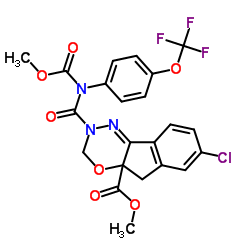DPX-JW062

DPX-JW062 structure
|
Common Name | DPX-JW062 | ||
|---|---|---|---|---|
| CAS Number | 144171-61-9 | Molecular Weight | 527.834 | |
| Density | 1.5±0.1 g/cm3 | Boiling Point | 571.4±60.0 °C at 760 mmHg | |
| Molecular Formula | C22H17ClF3N3O7 | Melting Point | 139-141ºC | |
| MSDS | Chinese USA | Flash Point | 299.3±32.9 °C | |
| Symbol |



GHS06, GHS08, GHS09 |
Signal Word | Danger | |
|
Reduced-risk pest management programs for eastern U.S. peach orchards: effects on arthropod predators, parasitoids, and select pests.
J. Econ. Entomol. 107(3) , 1084-91, (2014) We developed new integrated pest management programs for eastern U.S. peaches with minimal use of organophosphates. From 2002-2005, we assessed the ecological impacts of these reduced-risk programs versus grower standard conventional programs that still relie... |
|
|
Widely used pesticides with previously unknown endocrine activity revealed as in vitro antiandrogens.
Environ. Health Perspect. 119 , 794-800, (2011) Evidence suggests that there is widespread decline in male reproductive health and that antiandrogenic pollutants may play a significant role. There is also a clear disparity between pesticide exposure and data on endocrine disruption, with most of the publis... |
|
|
First report of field evolved resistance to agrochemicals in dengue mosquito, Aedes albopictus (Diptera: Culicidae), from Pakistan.
Parasit. Vectors 4 , 146, (2011) Agrochemicals have been widely used in Pakistan for several years. This exposes mosquito populations, particularly those present around agricultural settings, to an intense selection pressure for insecticide resistance. The aim of the present study was to inv... |
|
|
Impact of insecticide and fungicide residue contact on plum curculio, Conotrachelus nenuphar (Herbst), mobility and mortality: implications for pest management.
Pest Manag. Sci. 69 , 464-70, (2013) An evaluation was made of the effects of seven neurotoxic insecticides (esfenvalerate, indoxacarb, clothianidin, thiacloprid, azinphosmethyl, phosmet and imidacloprid), one insect growth regulator (novaluron) and two fungicides (myclobutanin and mancozeb), wi... |
|
|
A critical assessment of the effects of Bt transgenic plants on parasitoids.
PLoS ONE 3 , e2284, (2008) The ecological safety of transgenic insecticidal plants expressing crystal proteins (Cry toxins) from the bacterium Bacillus thuringiensis (Bt) continues to be debated. Much of the debate has focused on nontarget organisms, especially predators and parasitoid... |
|
|
Field evolved resistance in Helicoverpa armigera (Lepidoptera: Noctuidae) to Bacillus thuringiensis toxin Cry1Ac in Pakistan.
PLoS ONE 7 , e47309, (2012) Helicoverpa armigera (Hübner) is one of the most destructive pests of several field and vegetable crops, with indiscriminate use of insecticides contributing to multiple instances of resistance. In the present study we assessed whether H. armigera had develop... |
|
|
Efficacy of indoxacarb applied to cats against the adult cat flea, Ctenocephalides felis, flea eggs and adult flea emergence.
Parasit. Vectors 6 , 126, (2013) A study was conducted to evaluate the effect of indoxacarb applied to cats on adult cat fleas, Ctenocephalides felis, flea egg production and adult flea emergence.Sixteen cats were selected for the study and allocated to two treatment groups. Eight cats were ... |
|
|
Combination of phagostimulant and visual lure as an effective tool in designing house fly toxic baits: a laboratory evaluation.
PLoS ONE 8 , e77225, (2013) House flies (Diptera: Muscidae), potential vectors of a variety of pathogens, characteristically search and feed on sugar sources just after emergence for their survival. Phagostimulants like sugars, and visual characteristics of feeding materials play an imp... |
|
|
Evaluation of indoxacarb and fipronil (s)-methoprene topical spot-on formulations to control flea populations in naturally infested dogs and cats in private residences in Tampa FL. USA.
Parasit. Vectors 6 , 366, (2014) A study was conducted to evaluate and compare the effectiveness of two different spot-on topical flea products to control flea infestations on naturally infested dogs and cats in Tampa, FL USA.Thirty-two dogs and 3 cats with natural flea infestations living i... |